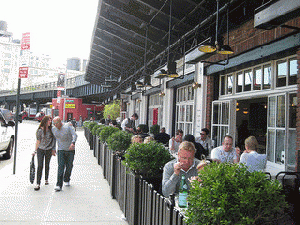| Back OpEd News | |||||||
|
Original Content at https://www.opednews.com/articles/Gentrification-Is-Merely-t-by-Justin-Samuels-Banks_Bloomberg_Change_Economy-140130-561.html (Note: You can view every article as one long page if you sign up as an Advocate Member, or higher). |
|||||||
January 30, 2014
Gentrification Is Merely the Transformation Of Large Cities Into Post Industrial Cities
By Justin Samuels
Gentrification is much more than rich people buying up poor neighborhoods.
::::::::
Gentrification has become an extremely loaded term. A number of critics have claimed that is displaced the poor and marginalized in favor of the wealthier. While this is true to an extent, it takes the 20th century history of cities like New York out of context and focuses only on where these cities were from the 1990s to the present. By doing that, it doesn't show what really has been going on with the national economy.
From the late 1800s to the 1960s, the US was in industrial expansion mode. The nation was building cities, building infrastructure such as modern highways, airports, seaports, and other facilities. Certain cities like New York were industrial centers. Many of the neighborhoods that would later on become ghettoes were in this area industrial neighborhoods full of factories, warehouses, freight train yards and if they were near the water, places for ships to dock. But by the end of the 1960, several changes happened. Once the US was finished with hard core development, it didn't need the same manufacturing capacity. After World War II, with Europe and Asia wrecked and Latin America and Africa underdeveloped, the US was the world's sole major industrial country. In the decades after World War II, the European and Japanese recoveries created formidable competitors to US industrial companies. The same amount of industrial capacity wasn't needed. In order to be compete on price, industrial companies started to leave the Northeast and Midwest for Southern states. By the 1970s the rust belt was in full decline, and New York was in fiscal crises. Industries and shipping left New York for New Jersey (Port Elizabeth takes ships from the ocean). Former industrial areas and the neighborhoods where there employees lived became ghettos. Many of the people who once worked at these jobs moved away to the Sunbelt. This was urban disinvestment. As big companies no longer hired in major cities, other companies like banks, decent grocery stores, and other major retailers didn't serve these inner cities areas anymore. This made these neighborhoods even less desirable places to live. In response landlords often rented out to Section 8 clients. The war on poverty meant there was now much more money available for welfare.
In the New York context, by the crack cocaine era big parts of the city became ghetto by 1990. Northern Brooklyn, Northern Manhattan, big parts of Western Manhattan, the Lower East Side, LIC, and parts of the Rockaways were crime ridden slums. But after the end of the crack cocaine era, mayors like Giuliani and Bloomberg gave New York City a different image. Again New York and other big cities had major investment. By then the US companies had new industrial competition from China, Mexico, Brazil, India, and other emerging markets. The companies the biggest cities attracted were services. Financial services, the creative sector, education, and STEM jobs. The tech sector is now New York's second largest generator of income after financial services. So cities again became attractive places to live. The big cities like New York and Los Angeles became global cities. As global cities they use their name to attract tourists, students, and business people. A good portion of these people live in the city on a part time basis. A number of poor neighborhoods were convenient to major business centers. Real estate development replaced run down tenements with modern housing. Grocery stores, banks, and major retailers returned. And landlords in these areas rejected government programs. Clearly this transformation had both good and bad effects. But it wasn't a simple matter of rich people pushing poor people out. It was a matter of cities transforming from industrial cities to cities fueled by government programs to cities fueled by various types of services jobs and new industries. In short, it was really just change. Societies always change and change always has both good and bad consequences. But we all have to live with the change regardless, and the past is gone.Authors Website: http://twitter.com/#!/screenwriter32
Authors Bio:
Screenwriter. Historian. BA in History and certificate in Latin American studies from Cornell University. MA in English Education from Columbia University. Very interested in public policy.
